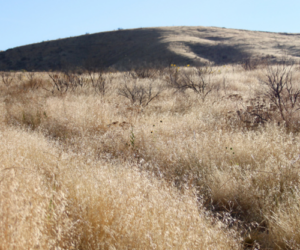Invasive Species
Course registration
Annual conference focused on educational presentations regarding noxious weeds, identification, and management for the Southwest.
Early Registration: $150 (Mar. 1 – June 30)
Regular Registration: $175 (July 1 – Aug. 4)
Late Registration: $200 (Aug. 5 – 7)
View article.
We measured soil organic carbon (SOC) and its particulate organic carbon (POC) and mineral-associated organic carbon (MAOC) constituents in the surface soils of sites that had sagebrush canopies but differed in whether their understories had been invaded by cheatgrass or not, in both warm and relatively colder ecoregions of the western USA. MAOC stocks were 36.1% less in the 0–10 cm depth and 46.1% less in the 10–20 cm depth in the cheatgrass-invaded stands compared to the uninvaded stands of the warmer Colorado Plateau, but not in the cooler and more carbon-rich Wyoming Basin ecoregion. In plots where cheatgrass increased SOC, it was via unstable POC. These findings indicate that cheatgrass effects on the distribution of soil carbon among POC and MAOC fractions may vary among ecoregions, and that cheatgrass can reduce forms of carbon that are otherwise considered stable and ‘secure’, i.e. sequestered.
View article.
We studied the impact of increased fire frequencies on the composition and abundance of herbaceous and woody species in the Interior Coast Range of northern California. Our study area is one of the most frequently burned areas in California, which allowed us to investigate higher fire frequencies than previously published in the scientific literature for California. We surveyed fifty-four 250-m2 plots to assess changes in plant community composition and postfire regeneration of chaparral shrubs across a wide range of fire frequencies, including plots that have burned up to six times in the past 30 years. Our findings reveal that short-interval fires significantly reduced postfire native woody regeneration, with obligate seeding species experiencing a 99% reduction and facultative species showing an 83% reduction in regeneration in the most frequently burned plots. Moreover, the overall marginal effect of one additional fire since 1985 decreased the proportion of native species cover by 12% and both richness and Shannon diversity by 4%. Consequently, areas with higher fire recurrence supported a more structurally and botanically homogeneous landscape dominated by a homogeneous group of non-native species.
View article.
The rate of change in invasive annual grass cover describes the trajectory of invasion. This information can be used to fine-tune priority locations and strategies for invasive species treatments. We identified locations with positive, neutral, negative, and variable rates of change. Although rates of change have accelerated, there were many locations with a consistent neutral rate of change in cover. High positive rates of change frequently preceded high invasive annual grass cover, and locations that had low cover rarely had a history of high positive rates of change. We identified potential management opportunities by combining rates of change in cover and percent cover data, illustrating both invasion severity and trajectory. We applied these potential opportunities to a map of the sagebrush biome using example thresholds. This map identifies locations that could be prioritized for different management goals and shows how those areas align with the Sagebrush Conservation Design management
View article.
This study aimed to determine the flammability of cheatgrass compared to two native perennial grasses (Columbia needlegrass [Achnatherum nelsonii] and bluebunch wheatgrass [Pseudoroegneria spicata]) across a range of fuel moistures. All three grass species had decreased flammability with increasing fuel moisture. Columbia needlegrass averaged 11% lower mass consumption than cheatgrass, and bluebunch wheatgrass had longer flaming duration and higher maximum temperatures than cheatgrass and Columbia needlegrass. The addition of cheatgrass to each perennial grass increased combined mass consumption, flaming duration, and flame heights. For these three attributes, the impact differed by the amount of cheatgrass in the mixture. Maximum and mean temperatures during perennial grass combustion were similar with and without cheatgrass addition. Some attributes of Columbia needlegrass flammability when burned with cheatgrass were higher than expected based on the flammability of each species, suggesting that Columbia needlegrass may be susceptible to pre-heating from combustion of cheatgrass. Conversely, the flammability of bluebunch wheatgrass and cheatgrass together had both positive and negative interactive effects, suggesting the impact on joint flammability from cheatgrass differs by perennial grass species.
The US Geological Survey Land Management Research Program and the Great Basin Fire Science Exchange teamed up to bring you updates in sagebrush, fire, and wildlife related research. On 2/27/2025, USGS researchers, Matt Germino, Doug Shinneman, and Beth Horning shared research on fuels, fuel breaks, and economics useful to decision making, Matt Germino and Morgan Roche shared research on herbicide treatments for invasive annual grasses, and Lea Condon shared research on the threats to biocrust in sagebrush ecosystems. Below are the webinar recording and resources associated with each presentation.
To view a complete list of resources (completed and planned), please view the program for this slate of presentations.
2/27 – Fire, fuels management, and invasive species
Webinar recording
Longevity of herbicides targeting exotic annual grassed in sagebrush-steppe soils
Project webpage
Patchy response of cheatgrass and nontarget vegetation to indaziflam and imazapic applied after wildfire in sagebrush steppe
A collaborative and iterative framework for delivering applied fuel break science: With a focus on sagebrush ecosystems and the Great Basin
Project webpage
Future direction of fuels management in sagebrush rangelands
UAS survey of sagebrush fuel breaks
Project webpage
Invasive annual grass – An economic assessment
Project webpage
Longevity of herbicides targeting exotic annual grasses in sagebrush-steppe soils
Project webpage
Intra-site sources of restoration variability in severely invaded rangeland: Strong temporal effects of herbicide–weather interactions; weak spatial effects of plant community patch type and litter
Synthesis of indaziflam outcomes for protecting sagebrush ecosystems
Project webpage
Can ruderal components of biocrust be maintained under increasing threats of drought, grazing, and wild horses?
Project webpage
Season of grazing interacts with soil texture, selecting for associations of biocrust morphogroups
Biological soil crusts are more prevalent in warmer and drier environments within the Great Basin ecoregion: Implications for managing annual grass invasion
The US Geological Survey Land Management Research Program and the Great Basin Fire Science Exchange teamed up to bring you updates in sagebrush, fire, and wildlife related research. On 2/6/2025, USGS researchers, Stephen Boyte and Morgan Roche shared their latest research on cheatgrass and fine fuels, Bryan Tarbox and Erica Christensen shared research on restoration treatment effectiveness, and Cam Aldridge and Cara Applestein shared research on monitoring and predictions to help restoration. Below are the webinar recording and resources associated with each presentation.
To view a complete list of resources (completed and planned), please view the program for this slate of presentations.
Individual presentations and associated resources, within the project webpage with links to data and publications:
Develop annual herbaceous percent cover maps in near-real time
Project webpage
Exotic annual data
Proliferation of fine fuels: Assessing under future climatic conditions
Optimizing Sagebrush Restoration project webpage
Proliferations project webpage
Optimizing sagebrush restoration and management actions to increase connectivity within the Sagebrush Conservation Design
Project webpage
Prioritizing Restoration of Sagebrush Ecosystems Tool (PreSET) decision-support tool
Leveraging soil, vegetation, fire, and land treatment data to inform restoration across the sagebrush biome
The Sagebrush Conservation Design
Assessing cheatgrass treatment efficacy across the sagebrush biome
Project webpage
Sagebrush recovery modeling website and associated projects
Sagebrush recovery projections layers
Leveraging soil, vegetation, fire, and land treatment data to inform sagebrush restoration
Simulating trends in land health components under treatment scenarios and Sagebrush Conservation Design
Project webpage
Sagebrush biome-wide vegetation change monitoring and warning system
Project webpage
Vectors of annual grass invasion – Roche et al. Predicting reburn risk to restoration investments
Projects webpage
Register for Level 2 Field Workshop in Idaho Falls, ID
This two-day workshops are designed to take an in depth look at how you can apply a set of principles and tools to strategically manage IAGs in both Eastern Idaho and Northern Great Basin. Our target audience includes both land managers and producers. Whether you are from the area or from the greater western US, these workshops are designed to help participants gain knowledge about how to best tackle IAGs through conversations about various management practices depending on invasion severity and recovery potential. Management goals can vary depending on how success is defined.
Additionally, we will visit a spectrum of sites from intact core areas to other rangelands areas. At these various sites, we will talk about potential management tactics and explore how different government agencies are tackling the issue based on various circumstances. Through this field workshop, our goal is to have participants become more confident with the different planning and management tools and help them to determine best management tactics to fit their situations.
Register for Level 2 Field Workshop in Elko, NV
This two-day workshops are designed to take an in depth look at how you can apply a set of principles and tools to strategically manage IAGs in both Eastern Idaho and Northern Great Basin. Our target audience includes both land managers and producers. Whether you are from the area or from the greater western US, these workshops are designed to help participants gain knowledge about how to best tackle IAGs through conversations about various management practices depending on invasion severity and recovery potential. Management goals can vary depending on how success is defined.
Additionally, we will visit a spectrum of sites from intact core areas to other rangelands areas. At these various sites, we will talk about potential management tactics and explore how different government agencies are tackling the issue based on various circumstances. Through this field workshop, our goal is to have participants become more confident with the different planning and management tools and help them to determine best management tactics to fit their situations.
Workshop resources, recordings.
Invasive annual grasses (IAG) – including cheatgrass, medusahead, ventanata, and others – continue to be a primary cause of rangeland degradation in the western US. In this workshop, we build upon concepts presented in previous events (see https://www.invasivegrasses.com/virtual-workshop) and focus specifically on turning strategies into action for managing IAG. Not only will we learn about the most current science around managing IAG, we will also hear success stories from ongoing projects and partnerships around the West.
You asked for it, you get it! A major component of this year’s virtual workshop will focus on answering questions submitted by you, the participants. We have compiled a list of questions submitted by previous workshop participants and will combine them with questions you can submit when you register to provide specific responses to those questions. Together, we will explore uniting landscape-scale strategic conservation concepts with targeted, on-the-ground management techniques specifically designed to meet vegetation management goals.






